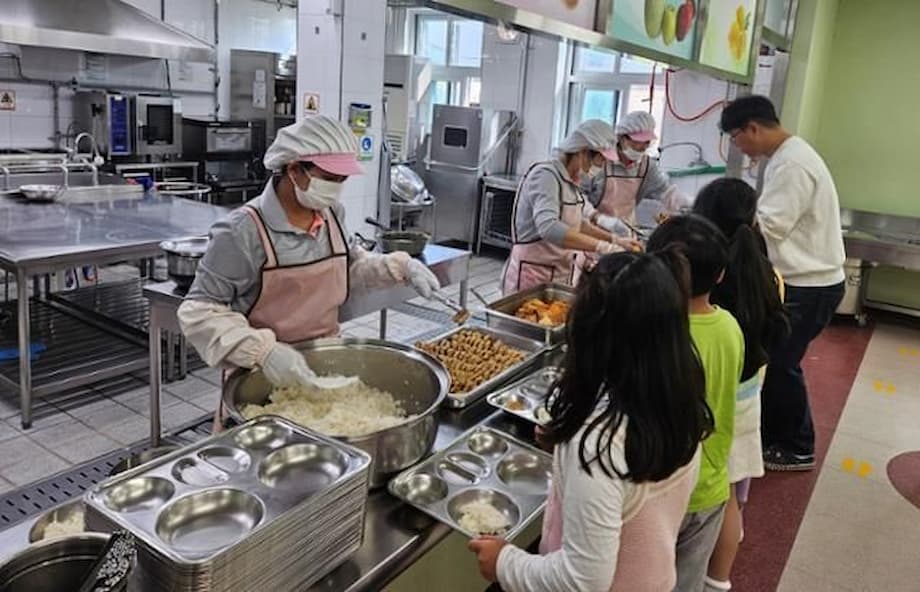Behind the praise, a workforce under strain
Videos of Korean school lunches flood social media feeds. Trays piled with crispy prawns and tartar sauce, egg fried rice, beef noodle soup, fresh fruit salad, kimchi and even ice cream have earned breathless captions and millions of views. The images appeal for a simple reason. The food looks like something a parent would cook at home, and in Korea these hot meals are provided free in public schools. For many viewers abroad, these clips stand in contrast to the cafeteria food they knew as children. For families in Korea, the program feels like a promise kept to every student, regardless of income.
- Behind the praise, a workforce under strain
- Inside a school kitchen in Korea
- Illness and injury linked to the kitchen
- Why protection lags in school kitchens
- A gendered labor system hiding in plain sight
- How Korea built universal free, eco friendly school meals
- Can robots ease the burden
- What workers say they need now
- What parents and students can do
- What to Know
What the camera rarely shows is who makes those meals and what it costs them. Behind the glossy trays stand tens of thousands of kitchen staff, mostly women in their 40s and 50s, who work on tight schedules and shoulder heavy physical loads for little more than the legal minimum wage. They chop vegetables by the crate, lift vats of soup, tend large fryers and griddles, and race the clock so lunch starts on time. Many speak of pain that does not fade, of coughs that do not go away, and of a fear that the kitchen air itself is making them sick.
Public pride in the meal program is deep. The food is free, varied and tied to local ingredients in many districts. The result is a global reputation that school lunches in Korea rank among the best. That reputation, however, has masked a human story. The labor is intense, kitchens are often under staffed, and safety protections have lagged behind what the job demands.
Collective action is difficult. There is a strong social expectation that school meals never stop. When kitchen workers have walked out, some parents and media voices accused them of starving children, while the reasons for the protests drew far less attention. The day the lunch tray is light or the soup is thin often becomes the main headline, not the years of strain and exposure that led workers to protest in the first place.
Inside a school kitchen in Korea
The job is often described as factory work disguised as cooking. A single middle school in Daejeon counted eight kitchen workers serving 890 students each day. On one day, a dispute over who should cut sheets of seaweed ended with seaweed soup served without seaweed. To someone outside the kitchen, that can sound absurd. To those inside, it captures the reality that small steps matter when you are cooking for hundreds of students on a fixed schedule with a small team.
Typical lunches look like home cooking, not bulk reheating. Rice is steamed, soups simmer, and two to three side dishes must be cooked and seasoned. Even a basic side can require soaking, shredding, blanching, stir frying and cooling. Many schools also serve fresh fruit, which means washing, trimming and portioning. After lunch is plated and served, the same team must clean industrial equipment and prepare for the next day.
A day of many steps
Consider a single dish like stir fried vegetables. Staff arrive early to receive deliveries, sort and inspect produce, wash and tune knives, then move bins to prep stations. They trim and slice vegetables, blanch and cool batches, heat oil in deep pans, and stir in seasoning at the right moment. Heavy stainless pans must be lifted and tilted carefully to avoid burns. Meanwhile, soup needs attention, rice must finish on time, and fruit must be portioned. Any hiccup early in the day can ripple into rushed work and a higher risk of mistakes or injuries later.
Staffing shortages compound the pressure. Hiring campaigns in some districts have drawn few applicants compared with the number of open posts, and turnover is high. Workers point to a gap between what the job requires and what it pays or protects. Better pay and safer conditions in manufacturing and logistics draw potential hires away. The result is a cycle familiar across public service kitchens, where the work never gets smaller even when the team does.
Illness and injury linked to the kitchen
Many school kitchen workers report chronic pain in their backs, shoulders and hands. Repetitive peeling and chopping can deform joints over time. Slips on wet floors, burns from hot oil, steam and soup, and cuts from knives are constant risks. Surveys and compensation cases suggest an injury rate far above the national average, which is not surprising given the combination of heat, speed and heavy lifting in a confined space.
The gravest hazards travel through the air. Cooking oil fumes contain tiny particles and gases that can inflame and scar the airways. High heat, poor ventilation and large batch frying can produce aldehydes like acrolein and formaldehyde, as well as polycyclic aromatic hydrocarbons. Studies of cooks in multiple countries link long exposure to these fumes with chronic cough, asthma like symptoms, chronic obstructive pulmonary disease and higher rates of lung cancer.
By the numbers
Health checks involving 42,077 school kitchen workers across Korea found that about one third had lung problems, including cancer. Around 170 workers have been officially recognized as having lung cancer tied to kitchen smoke exposure. In the past three years alone, at least 14 workers have died of lung cancer. Union advocates and occupational health experts say the real toll is likely higher, because strict criteria for industrial injury claims exclude many cases that do not fit narrow documentation rules or exposure histories.
Park Mi Hyang, a school kitchen worker and labor rights activist, framed the tradeoff bluntly at a parliamentary forum before fellow workers and lawmakers.
‘The world class free school meals South Koreans enjoy today came at the cost of kitchen workers’ deformed hands, burn scarred skin and the cancer cells growing in their lungs.’
Many workers remain reluctant to speak out. A high share are hired on contracts with limited job security. Some fear that complaining could label them as troublemakers in workplaces where the lunch bell rules the day. When the kitchen is short staffed and lunch must be ready, it can feel easier to shoulder the pain than to push for change and risk a backlash.
Why protection lags in school kitchens
Ventilation is the first line of defense against cooking fumes, yet it is missing or inadequate in most school kitchens. By workers’ estimates and local audits, more than 97 percent of kitchens lack safe ventilation. Older school buildings were not designed for heavy frying or mass cooking with efficient fume extraction. Retrofitting costs money and time, and it disrupts meal service. Where budgets are tight, ventilation projects slip behind more visible school needs.
Kitchen staff also face structural disadvantages. Many are classified as non regular workers in the public sector, which affects pay scales, benefits and bargaining power. Even where unions are present, public opinion can turn sharply against any action that interrupts school meals. During a strike at one elementary school in Suwon, students were served plain rice with dried seaweed. Some parents bought sandwiches to fill the gap. A longer strike forces families to pack lunches or keep children home, which quickly becomes a flashpoint. These pressures push safety talks to the side until another illness or injury draws short term attention.
Procurement rules and scheduling practices can add to strain. Deliveries that arrive late or in the wrong form, such as uncut produce for dishes that need precise sizing, turn small tasks into delays. Nutrition standards and menus built for variety and freshness, both worthy goals, require scratch cooking that takes more labor and better equipment. The system relies on that labor but historically has not funded the protections that scratch cooking demands at scale.
A gendered labor system hiding in plain sight
School kitchens are staffed mainly by women, many of them middle aged and returning to the workforce after raising children or looking for steady hours close to home. The work is often treated as an extension of unpaid care, rather than skilled, hazardous labor. In daily conversation and popular media, the term ajumma, a word for middle aged women that can be used dismissively, hangs over the job. This social framing has kept wages low and delayed investment in safety, even as kitchens have taken on more complex menus and higher expectations.
Researchers who study school food systems around the world have traced a common pattern. Care work, including feeding children, is feminized and undervalued in both pay and status. When programs depend on scratch cooking and service that looks like home, the invisible cost is the labor of women whose knowledge and effort make that possible. A different approach centers worker voice in policy, pays for the real skills required, invests in safe equipment, and gives communities a seat at the table when menus and procurement rules are set.
There is a broader labor story here too. Studies of platform workers and other precarious jobs in Korea show higher rates of musculoskeletal pain, fatigue and depression compared with the general population. The lesson is not that all these jobs are the same. It is that public services and low wage work often sit in a blind spot of social insurance and occupational health. School kitchens are a stark example of how that blind spot harms the people who feed children every day.
How Korea built universal free, eco friendly school meals
Korea did not arrive at today’s school food program by accident. Parents, educators and local leaders pushed for change after food safety scandals in the 2000s, arguing that students deserved healthy meals and that public money should support local farms. The result in many regions is a universal, free and eco friendly approach that favors fresh, locally grown ingredients and balanced menus. This is also why the food looks like home cooking. Scratch cooking with seasonal produce is part of the design, not a side effect.
The program has advanced several goals. It treats school meals as part of public health, not just a service. It supports regional farmers and shortens supply chains. It also builds food literacy by exposing students to a wider range of vegetables, grains and flavors. Many parents value the dignity of a free meal for all, which avoids singling out lower income students at the lunch line.
None of that comes free or easy at the kitchen level. Fresh, local and varied menus raise labor needs for prep and cooking. Ingredients arrive in forms that require cleaning and cutting. Safety needs rise with the heat of frying, the size of pots and the speed of service. If funding for ventilation, staffing and training fails to keep pace with menu ambition, risk lands on workers. The quality that viewers admire on social media is real. So is the strain on the people who create it.
Can robots ease the burden
Automation has emerged as one possible relief valve. Some schools now test cooking robots to handle specific tasks like frying, stir frying or simmering soups. In Seoul, one middle school uses four robots for these jobs. Incheon plans to invest hundreds of millions of won to install cooking robot systems in several schools. At trade fairs, companies showcase automated stirrers with camera based temperature monitoring that adjust heat on their own, robot arms that manage fryers and shake off oil, and machines that cook noodles from start to finish.
These tools can lower the risk of burns and reduce heavy lifting. If a robot stirrer turns a deep pan consistently, workers do not need to stand over hot oil for long stretches. If a robot arm loads and unloads a fryer, a cook avoids hot splashes and the awkward reach that often leads to shoulder injuries. In theory, staff time then shifts to supervision and seasoning instead of repetitive motion under heat.
Kitchen workers remain cautious for good reason. Current robots need human help at multiple steps. They may bring new safety questions, such as pinch points and unexpected movements in crowded kitchens. Most importantly, machines do not address the core mismatches in pay, staffing and ventilation. When tensions flare, even simple tasks like cutting seaweed for soup can reveal how fragile a kitchen schedule is. Workers say that real relief starts with better staffing ratios, schedules that allow recovery and equipment that removes smoke at the source.
What workers say they need now
Kitchen staff and their allies have outlined practical steps that would reduce harm. First, set and fund ventilation standards for school kitchens, including local exhaust systems for fryers and griddles, make up air to keep smoke moving out, and maintenance schedules that keep hoods working. Second, fund regular health screenings for respiratory and musculoskeletal conditions, with a clear path to compensation for work related illness. Third, set staffing ratios that account for scratch cooking, heavy lifting and service speed, and pay wages that reflect the skill and risk of the work.
Workers also want stable employment status, stronger training and protections that match other high risk public sector jobs. They point to how quickly applicants flock to safer, better paid factory posts with predictable schedules. If schools want to attract and keep skilled kitchen staff, they argue, the job must compete on pay, safety and respect.
At a recent rally, workers wore pink aprons and carried nameplates bearing the names of colleagues who died. One protester, diagnosed with work related lung cancer, spoke for many who kept cooking even as their bodies failed them.
‘For years I endured a bone crushing workload and the toxic smoke, trying to cook meals good enough for my own children too. Meanwhile, my body was breaking apart.’
What parents and students can do
Parents and students have more influence than they might think. School boards and education offices respond to community pressure and priorities. Asking for safe ventilation, adequate staffing and realistic menus signals that families care not only about what is on the tray, but also about who makes it. Accepting simpler menus during retrofits or staffing shortages can give kitchens breathing room without framing the change as failure.
Parent teacher groups can invite kitchen workers to speak about their jobs, build support for budget items that upgrade equipment, and push for transparent reporting on injuries and air quality. Students can learn why scratch cooking matters for health and taste, and why that quality should come with protections for workers. A lunch program that treats kitchen staff as essential professionals will serve healthier meals and a healthier school community.
What to Know
- Korean school lunches are free, scratch cooked and widely praised, but the labor behind them is intense and often unsafe.
- Most school kitchen workers are women in their 40s and 50s who earn near minimum wage while handling heavy loads and hot equipment on tight schedules.
- Injury risks run high and long term exposure to cooking fumes has been linked to chronic respiratory disease and lung cancer among staff.
- Health checks of 42,077 workers found about one third had lung problems, and about 170 cases of lung cancer have been officially tied to kitchen fume exposure.
- Ventilation is inadequate in most schools, with more than 97 percent of kitchens lacking safe fume extraction.
- Public pressure to keep lunches running makes strikes rare and controversial, which slows safety improvements.
- The program’s eco friendly and local sourcing goals are valuable, but they raise labor needs that must be matched with safer equipment and better staffing.
- Cooking robots are being tested to reduce burns and repetitive tasks, but they do not replace the need for fair pay, proper ventilation and realistic workloads.
- Workers call for enforceable ventilation standards, routine health screening, better staffing ratios, and pay that reflects skill and risk.
- Parents and students can support budget upgrades, accept simpler menus during safety projects, and back policies that treat kitchen staff as essential professionals.




